TOYOTA tC 2011 Owners Manual (in English)
Manufacturer: TOYOTA, Model Year: 2011, Model line: tC, Model: TOYOTA tC 2011Pages: 473, PDF Size: 10.91 MB
Page 141 of 473
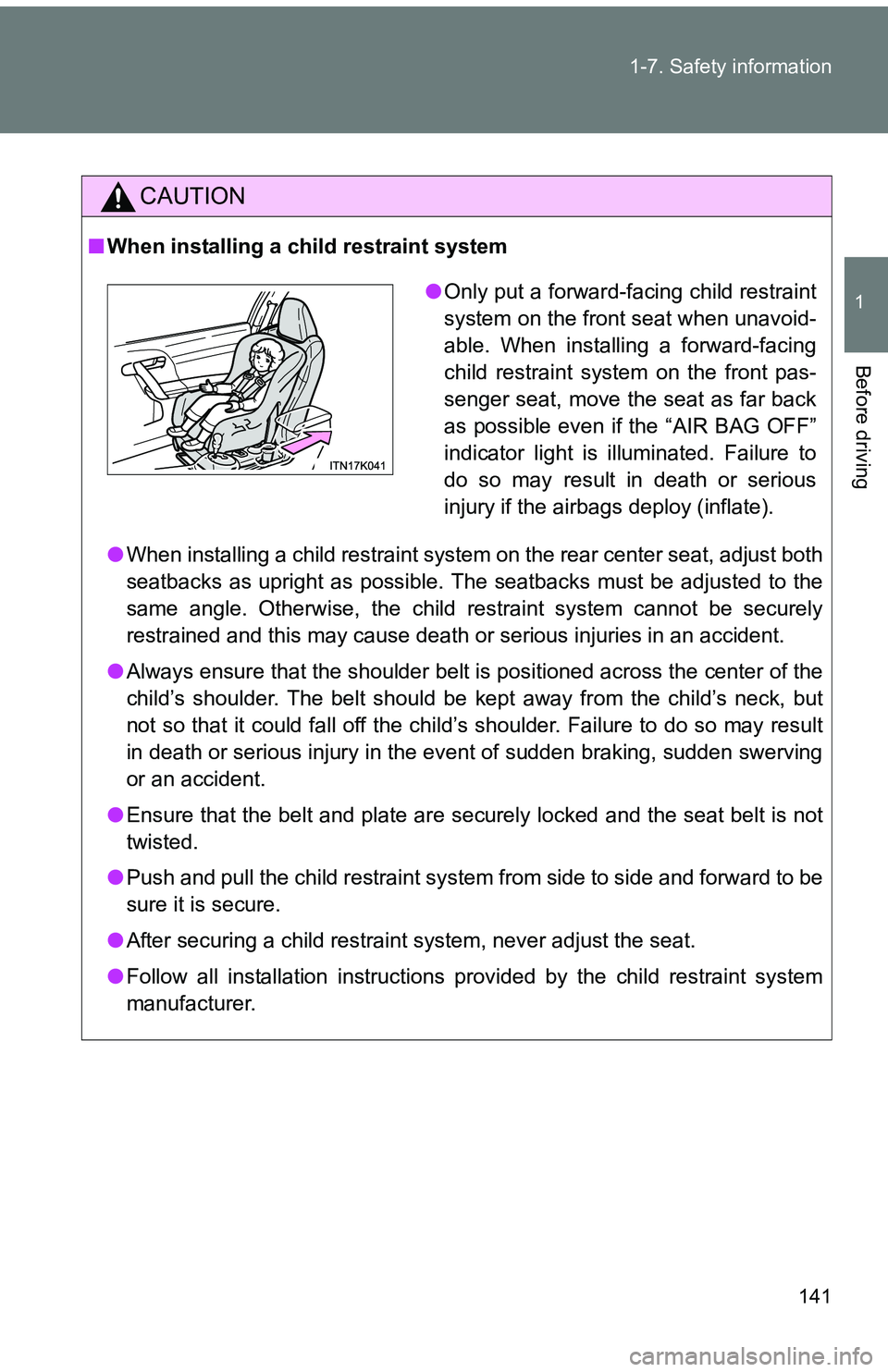
141
1-7. Safety information
1
Before driving
CAUTION
■
When installing a child restraint system
●When installing a child restraint system on the rear center seat, adjust both
seatbacks as upright as possible. The seatbacks must be adjusted to the
same angle. Otherwise, the child restraint system cannot be securely
restrained and this may cause death or serious injuries in an accident.
● Always ensure that the shoulder belt is positioned across the center of the
child’s shoulder. The belt should be kept away from the child’s neck, but
not so that it could fall off the child’s shoulder. Failure to do so may result
in death or serious injury in the event of sudden braking, sudden swerving
or an accident.
● Ensure that the belt and plate are securely locked and the seat belt is not
twisted.
● Push and pull the child restraint system from side to side and forward to be
sure it is secure.
● After securing a child restraint system, never adjust the seat.
● Follow all installation instructions provided by the child restraint system
manufacturer.
●Only put a forward-facing child restraint
system on the front seat when unavoid-
able. When installing a forward-facing
child restraint system on the front pas-
senger seat, move the seat as far back
as possible even if the “AIR BAG OFF”
indicator light is illuminated. Failure to
do so may result in death or serious
injury if the airbags deploy (inflate).
Page 142 of 473
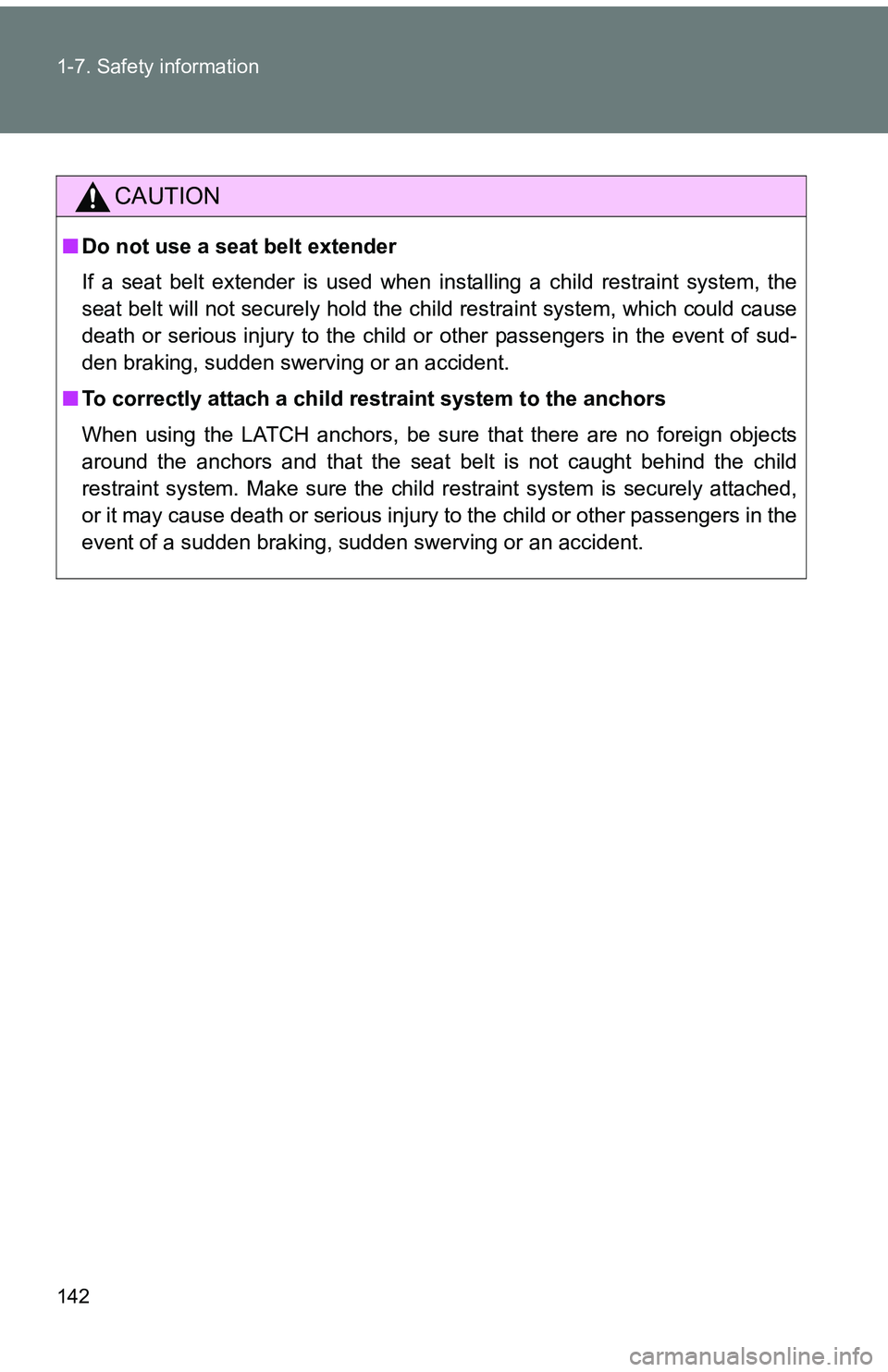
142 1-7. Safety information
CAUTION
■Do not use a seat belt extender
If a seat belt extender is used when installing a child restraint system, the
seat belt will not securely hold the child restraint system, which could cause
death or serious injury to the child or other passengers in the event of sud-
den braking, sudden swerving or an accident.
■ To correctly attach a child r estraint system to the anchors
When using the LATCH anchors, be sure that there are no foreign objects
around the anchors and that the seat belt is not caught behind the child
restraint system. Make sure the child restraint system is securely attached,
or it may cause death or serious injury to the child or other passengers in the
event of a sudden braking, sudden swerving or an accident.
Page 143 of 473

When driving2
143
2-1. Driving proceduresDriving the vehicle............ 144
Engine (ignition) switch (vehicles without a smart
key system).................... 159
Engine (ignition) switch (vehicles with a smart
key system).................... 163
Automatic transmission .... 172
Manual transmission ........ 179
Turn signal lever .............. 181
Parking brake ................... 182
Horn ................................. 183 2-2. Instrument cluster
Gauges and meters ......... 184
Indicators and warning lights .............................. 188
2-3. Operating the lights and Windshield wipers
Headlight switch ............... 193
Windshield wipers and washer ........................... 196
Rear window wiper and washer ........................... 198
2-4. Using other driving systems Cruise control ................... 200
Driving assist systems ..... 204
2-5. Driving information Cargo and luggage .......... 209
Vehicle load limits ............ 214
Winter driving tips ............ 215
Trailer towing ................... 221
Dinghy towing (automatic transmission) ................. 222
Dinghy towing (manual transmission) ................. 223
Page 144 of 473
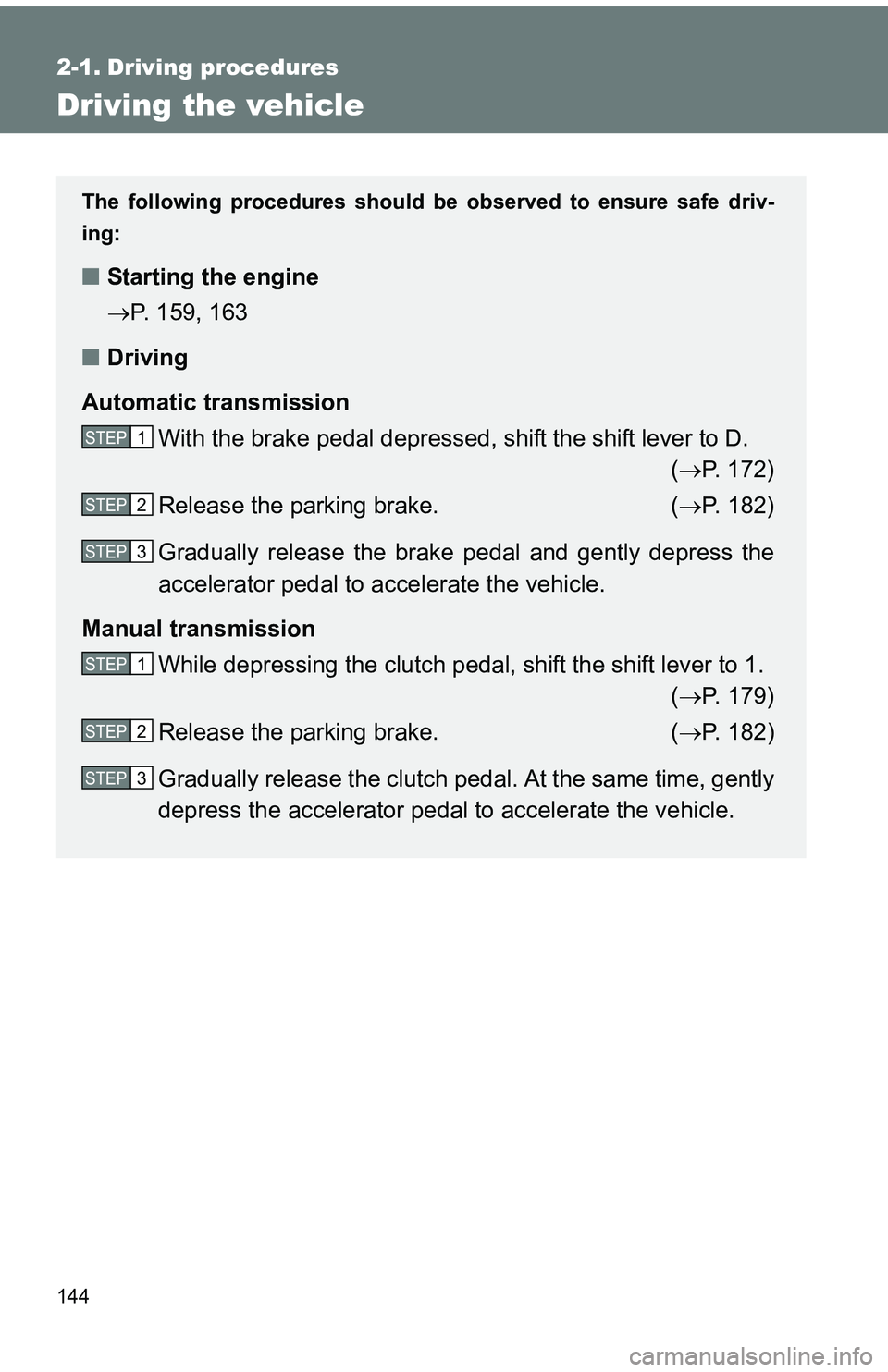
144
2-1. Driving procedures
Driving the vehicle
The following procedures should be observed to ensure safe driv-
ing:
■ Starting the engine
P. 159, 163
■ Driving
Automatic transmission With the brake pedal depressed, shift the shift lever to D. ( P. 172)
Release the parking brake. ( P. 182)
Gradually release the brake pedal and gently depress the
accelerator pedal to accelerate the vehicle.
Manual transmission While depressing the clutch pedal, shift the shift lever to 1. ( P. 179)
Release the parking brake. ( P. 182)
Gradually release the clutch pedal. At the same time, gently
depress the accelerator pedal to accelerate the vehicle.
STEP 1
STEP 2
STEP 3
STEP 1
STEP 2
STEP 3
Page 145 of 473
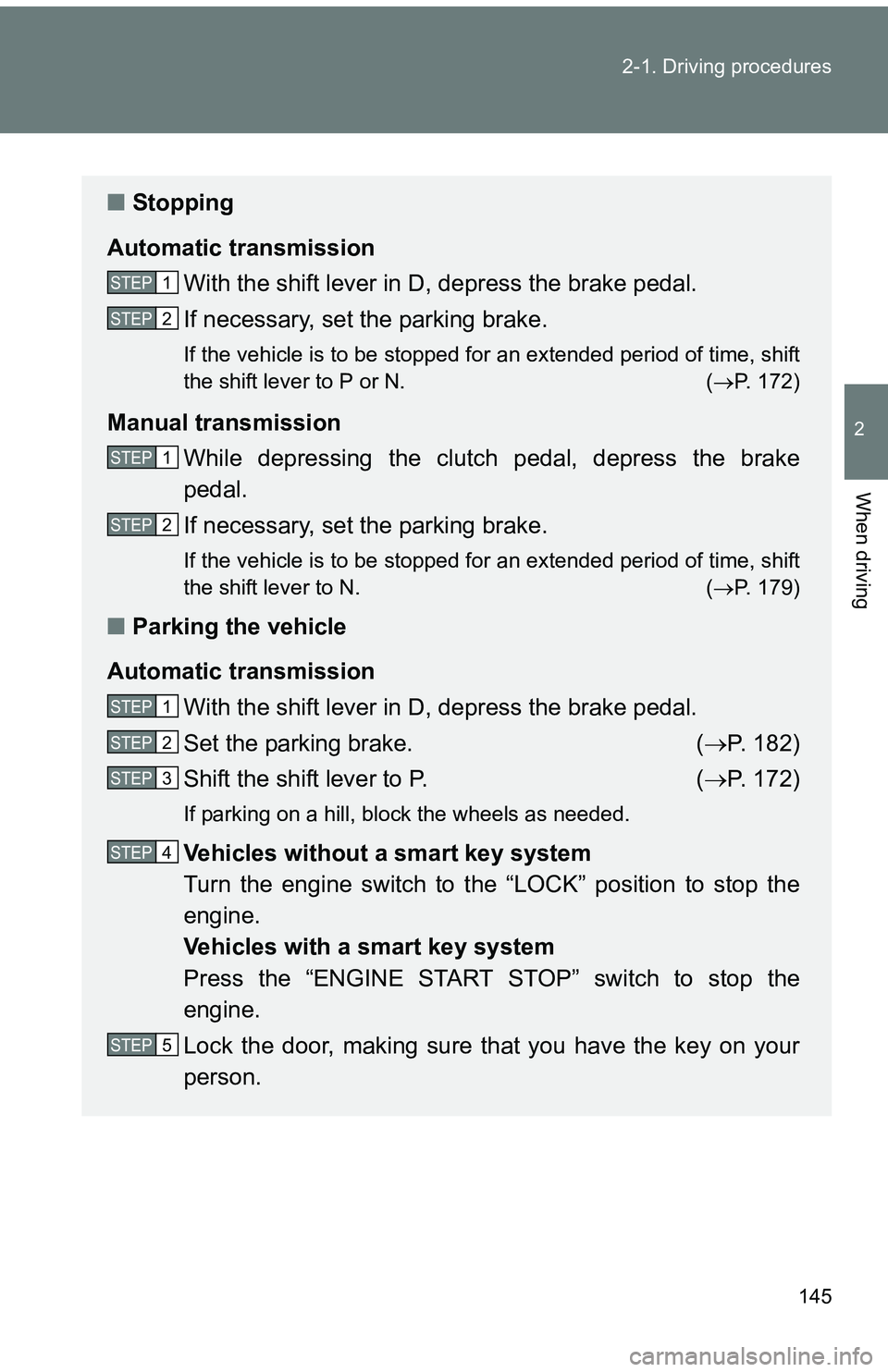
145
2-1. Driving procedures
2
When driving
■
Stopping
Automatic transmission With the shift lever in D, depress the brake pedal.
If necessary, set the parking brake.
If the vehicle is to be stopped for an extended period of time, shift
the shift lever to P or N. ( P. 172)
Manual transmission
While depressing the clutch pedal, depress the brake
pedal.
If necessary, set the parking brake.
If the vehicle is to be stopped for an extended period of time, shift
the shift lever to N. ( P. 179)
■Parking the vehicle
Automatic transmission With the shift lever in D, depress the brake pedal.
Set the parking brake. ( P. 182)
Shift the shift lever to P. ( P. 172)
If parking on a hill, block the wheels as needed.
Vehicles without a smart key system
Turn the engine switch to the “LOCK” position to stop the
engine.
Vehicles with a smart key system
Press the “ENGINE START STOP” switch to stop the
engine.
Lock the door, making sure that you have the key on your
person.
STEP 1
STEP 2
STEP 1
STEP 2
STEP 1
STEP 2
STEP 3
STEP 4
STEP 5
Page 146 of 473

146 2-1. Driving procedures
Starting off on a steep uphillAutomatic transmission Make sure that the parking brake is set and shift the shift lever
to D.
Gently depress the accelerator pedal.
Release the parking brake.
Manual transmission With the parking brake firmly set and the clutch pedal fully
depressed, shift the shift lever to 1.
Lightly depress the accelerator pedal at the same time as
gradually releasing the clutch pedal.
Release the parking brake.
Manual transmissionWhile depressing the clutch pedal, depress the brake
pedal.
Set the parking brake. ( P. 182)
Shift the shift lever to N. ( P. 179)
If parking on a hill, shift the shift lever to 1 or R and block the
wheels as needed.
Vehicles without a smart key system
Turn the engine switch to the “LOCK” position to stop the
engine.
Vehicles with a smart key system
Press the “ENGINE START STOP” switch to stop the
engine.
Lock the door, making sure that you have the key on your
person.
STEP 1
STEP 2
STEP 3
STEP 4
STEP 5
STEP 1
STEP 2
STEP 3
STEP 1
STEP 2
STEP 3
Page 147 of 473
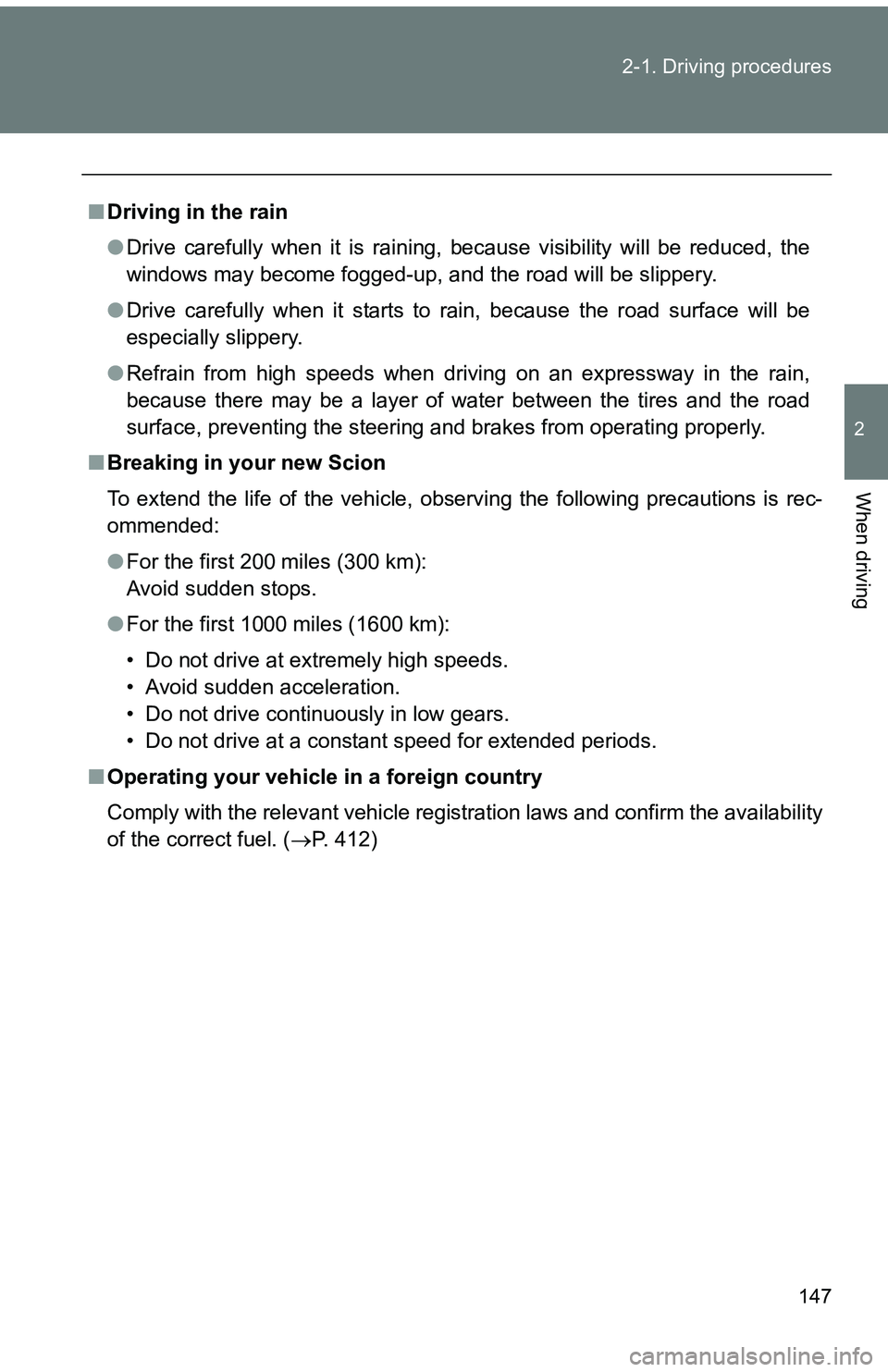
147
2-1. Driving procedures
2
When driving
■
Driving in the rain
●Drive carefully when it is raining, because visibility will be reduced, the
windows may become fogged-up, and the road will be slippery.
● Drive carefully when it starts to rain, because the road surface will be
especially slippery.
● Refrain from high speeds when driving on an expressway in the rain,
because there may be a layer of water between the tires and the road
surface, preventing the steering and brakes from operating properly.
■ Breaking in your new Scion
To extend the life of the vehicle, observing the following precautions is rec-
ommended:
●For the first 200 miles (300 km):
Avoid sudden stops.
● For the first 1000 miles (1600 km):
• Do not drive at extremely high speeds.
• Avoid sudden acceleration.
• Do not drive continuously in low gears.
• Do not drive at a constant speed for extended periods.
■ Operating your vehicle in a foreign country
Comply with the relevant vehicle registration laws and confirm the availability
of the correct fuel. ( P. 412)
Page 148 of 473
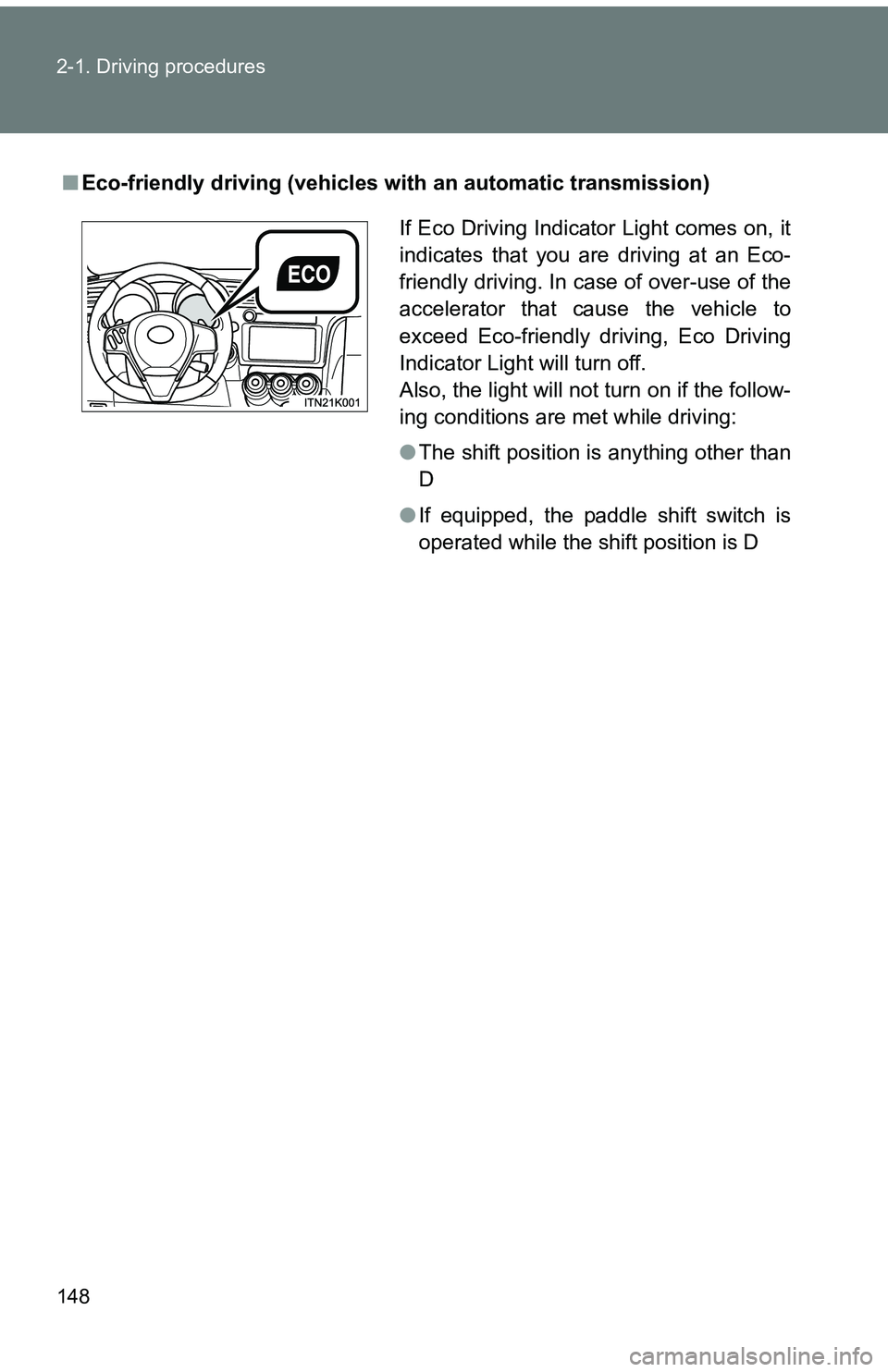
148 2-1. Driving procedures
■Eco-friendly driving (vehicles wi th an automatic transmission)
If Eco Driving Indicator Light comes on, it
indicates that you are driving at an Eco-
friendly driving. In case of over-use of the
accelerator that cause the vehicle to
exceed Eco-friendly driving, Eco Driving
Indicator Light will turn off.
Also, the light will not turn on if the follow-
ing conditions are met while driving:
●The shift position is anything other than
D
● If equipped, the paddle shift switch is
operated while the shift position is D
Page 149 of 473

149
2-1. Driving procedures
2
When driving
CAUTION
■
When starting the vehicle
On vehicles with an automatic transmission, always keep your foot on the
brake pedal while stopped with the engine running. This prevents the vehicle
from creeping.
■ When driving the vehicle
●Do not drive if you are unfamiliar with the location of the brake and accel-
erator pedals to avoid depressing the wrong pedal.
• Accidentally depressing the accelerator pedal instead of the brake
pedal will result in sudden acceleration that may lead to an accident
that could result in death or serious injury.
• When backing up, you may twist your body around, leading to a diffi- culty in operating the pedals. Make sure to operate the pedals properly.
• Make sure to keep a correct driving posture even when moving the vehicle only slightly. This allows you to depress the brake and acceler-
ator pedals properly.
• Depress the brake pedal using your right foot. Depressing the brake pedal using your left foot may delay response in an emergency, result-
ing in an accident.
● Do not drive the vehicle over or st op the vehicle near flammable materials.
The exhaust system and exhaust gases can be extremely hot. These hot
parts may cause a fire if there is any flammable material nearby.
● On vehicles with an automatic transmission, do not let the vehicle roll
backward while the shift lever is in a driving position, or roll forward while
the shift lever is in R.
Doing so may cause the engine to stall or lead to poor brake and steering
performance, resulting in an accident or damage to the vehicle.
Page 150 of 473
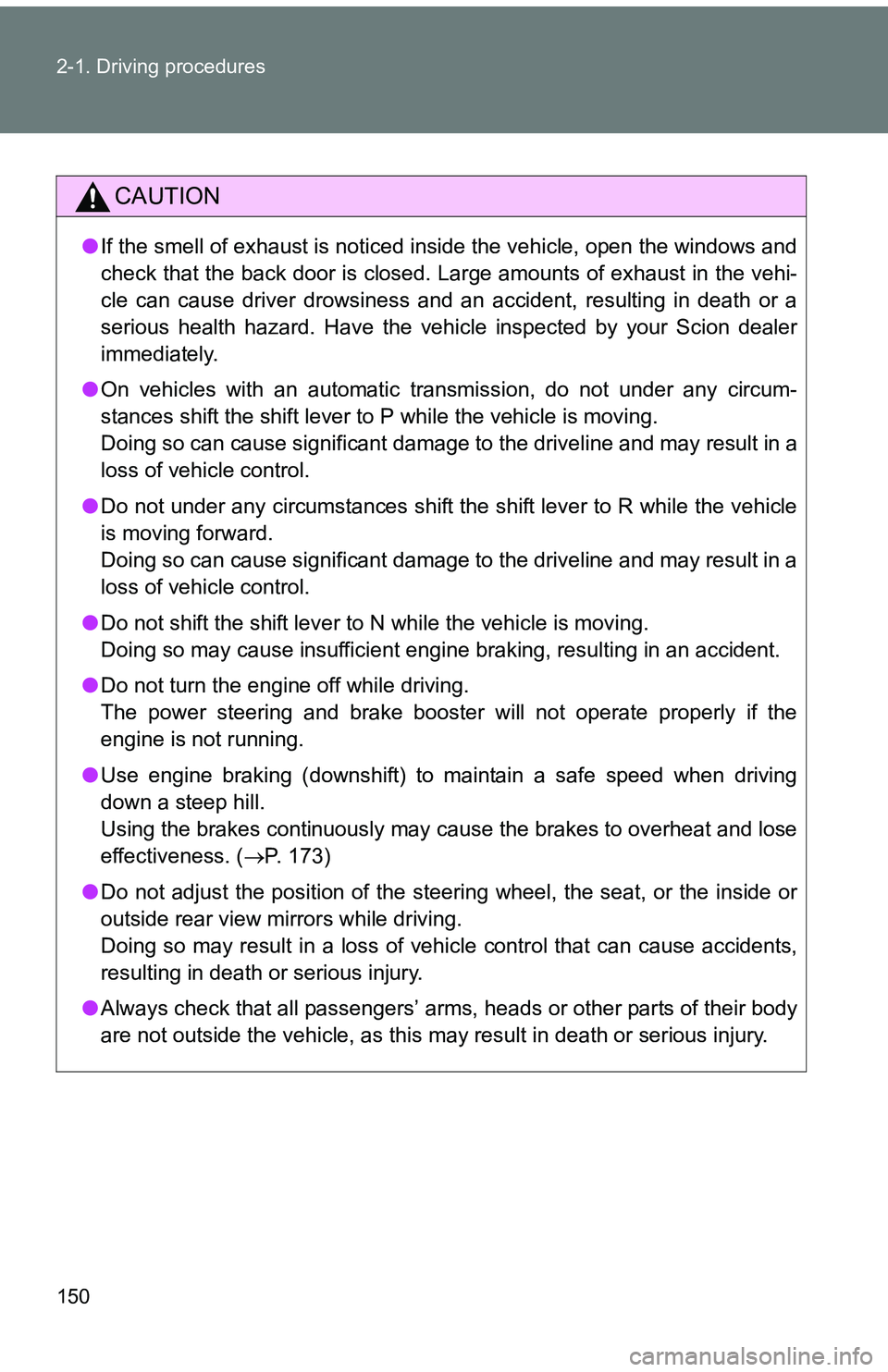
150 2-1. Driving procedures
CAUTION
●If the smell of exhaust is noticed inside the vehicle, open the windows and
check that the back door is closed. Large amounts of exhaust in the vehi-
cle can cause driver drowsiness and an accident, resulting in death or a
serious health hazard. Have the vehicle inspected by your Scion dealer
immediately.
● On vehicles with an automatic transmission, do not under any circum-
stances shift the shift lever to P while the vehicle is moving.
Doing so can cause significant damage to the driveline and may result in a
loss of vehicle control.
● Do not under any circumstances shift the shift lever to R while the vehicle
is moving forward.
Doing so can cause significant damage to the driveline and may result in a
loss of vehicle control.
● Do not shift the shift lever to N while the vehicle is moving.
Doing so may cause insufficient engine braking, resulting in an accident.
● Do not turn the engine off while driving.
The power steering and brake booster will not operate properly if the
engine is not running.
● Use engine braking (downshift) to maintain a safe speed when driving
down a steep hill.
Using the brakes continuously may cause the brakes to overheat and lose
effectiveness. ( P. 173)
● Do not adjust the position of the steering wheel, the seat, or the inside or
outside rear view mirrors while driving.
Doing so may result in a loss of vehicle control that can cause accidents,
resulting in death or serious injury.
● Always check that all passengers’ arms, heads or other parts of their body
are not outside the vehicle, as this may result in death or serious injury.